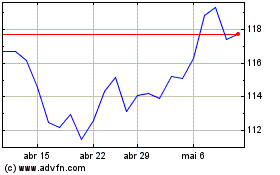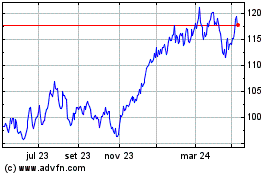U.S. Dollar Surges Broadly on Hawkish Fed
14 Dezembro 2016 - 8:54PM
Dow Jones News
By James Glynn
SYDNEY -- The U.S. dollar is sharply higher in early Asia
trading, with the yen hardest hit after the U.S. Federal Reserve
announced its first interest-rate increase in 2016 overnight and
signaled it expects to increase rates more quickly than previously
anticipated in 2017.
Fed officials said they would increase the federal-funds rate by
a quarter percentage point to between 0.50% and 0.75%, a move
consistent with a brightening economic outlook.
The Fed now expects the median fed-funds rate to be 1.4% by the
end of 2017, reaching 2.1% at the end of 2018 and 2.9% in 2019.
That implies three quarter-percentage-point interest-rate increases
over each of the next three years, a faster pace than officials
projected in September, when they only saw two rate increases next
year.
Currency traders said the full extent of the reaction to the Fed
rate increase won't be known until European markets have had time
to absorb the news.
The reaction in currency markets in early Asia has seen the U.S.
dollar jump to its highest levels since February against the yen,
with broad gains also posted against the euro and dollar bloc
currencies.
The U.S. dollar climbed above 117.0 yen after trading closer to
115.0 yen ahead of the Fed announcement. WSJ Dollar Index is up
0.8% to 91.12, which would mark its highest closing value in more
than 14 years. The Australian, Canadian and New Zealand dollars
were sharply lower against the greenback.
Richard Grace, the global head of currency strategy at the
Commonwealth Bank of Australia, said the Fed is navigating its way
through some tricky waters. Fed Chairwoman Janet Yellen has
acknowledged the potential for stronger GDP growth if big
infrastructure spending by the Trump White House occurs, while also
acknowledging monetary conditions have tightened in the past month
through a higher U.S. dollar and big increases in U.S. bond yields,
he said.
There was a fairly uniform rise in U.S. bond yields overnight,
with the 10-year yield climbing to 2.54% from around 2.44% on the
Fed announcement.
Ray Attrill, the global head of currency strategy at National
Australia Bank said "this is what happens when two (interest rate
increases) becomes three."
All currencies have been "smashed" against the U.S., with the
yen leading the pack
"Some of the (Fed) members are taking on board the prospect of
more growth-supportive and inflationary fiscal policy next year,"
Mr. Attrill said.
Still, Ms. Yellen has indicated that it is too early to make
assumptions about what might happen to the world's largest economy
if the budgetary purse strings in Washington are loosened next
year, Mr. Attrill added.
Traders said they were also on edge about the potential for
increased friction between the Fed and Mr. Trump.
Ms. Yellen had several opportunities to offer critiques of some
of the ideas that have been floated for economic policy but
refrained from taking the bait. Still, she emphasized the
importance of the Federal Reserve's independence several times.
Write to James Glynn at james.glynn@wsj.com
(END) Dow Jones Newswires
December 14, 2016 17:39 ET (22:39 GMT)
Copyright (c) 2016 Dow Jones & Company, Inc.
Commonwealth Bank Of Aus... (ASX:CBA)
Gráfico Histórico do Ativo
De Out 2024 até Nov 2024

Commonwealth Bank Of Aus... (ASX:CBA)
Gráfico Histórico do Ativo
De Nov 2023 até Nov 2024
